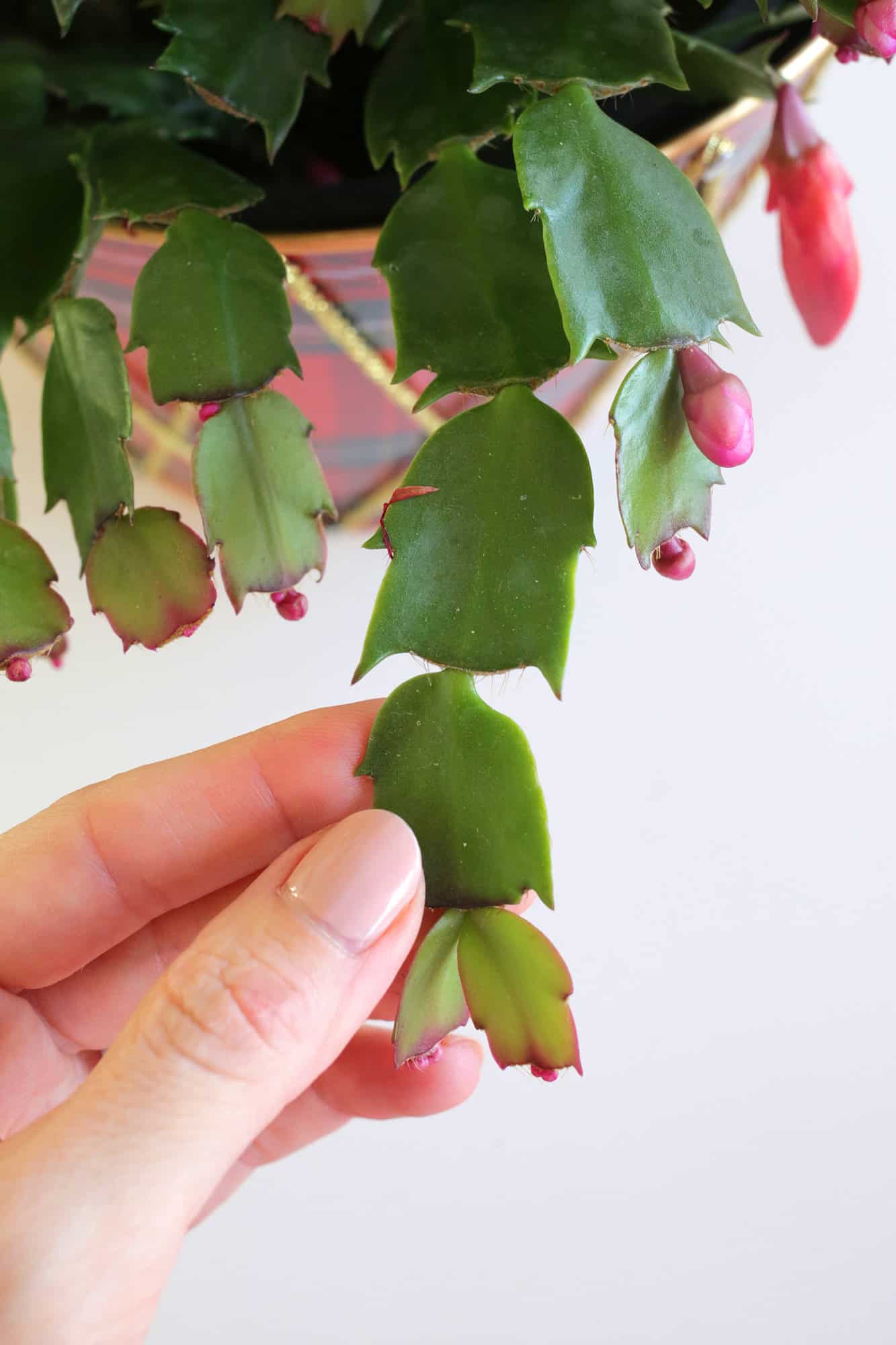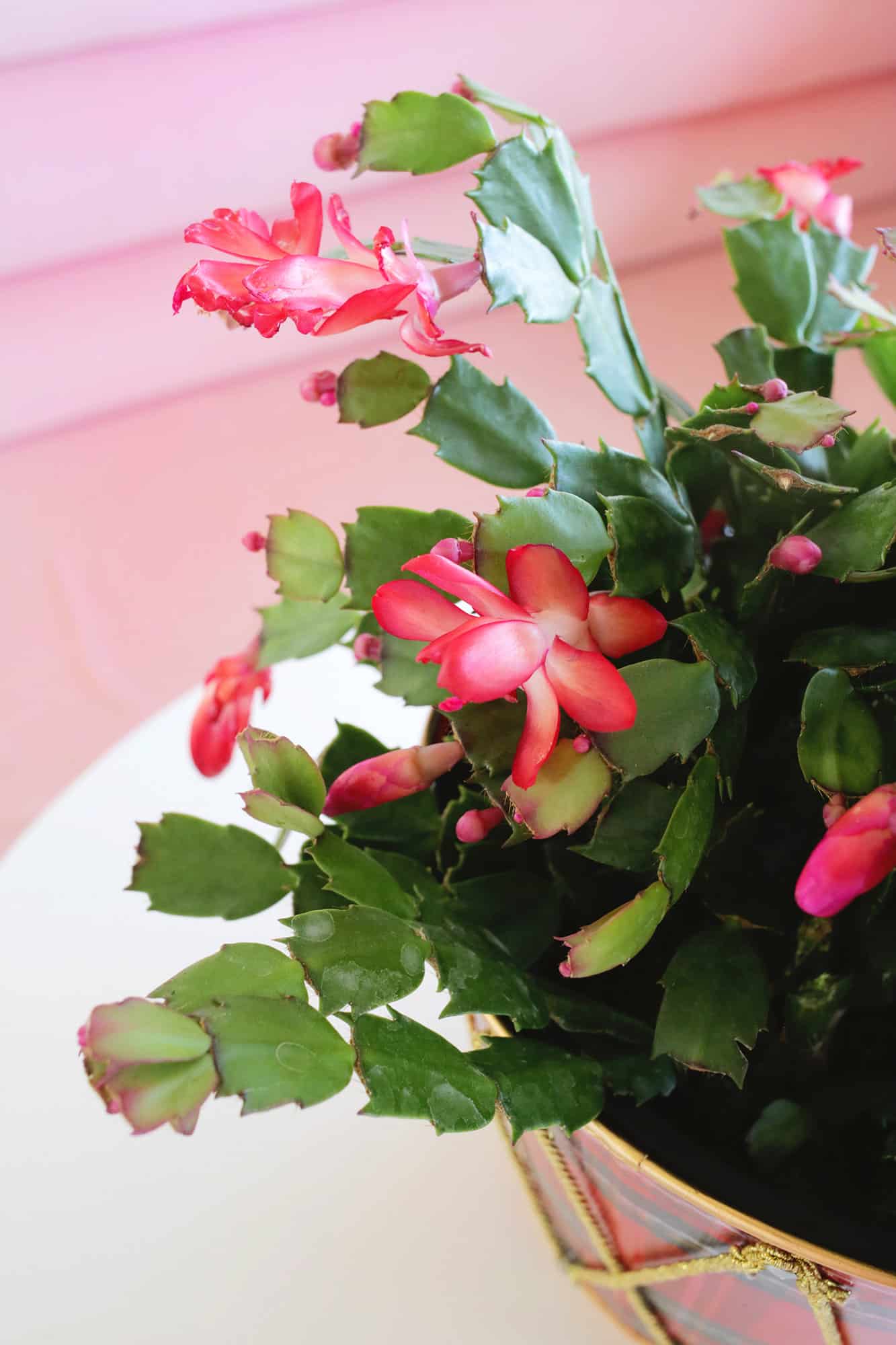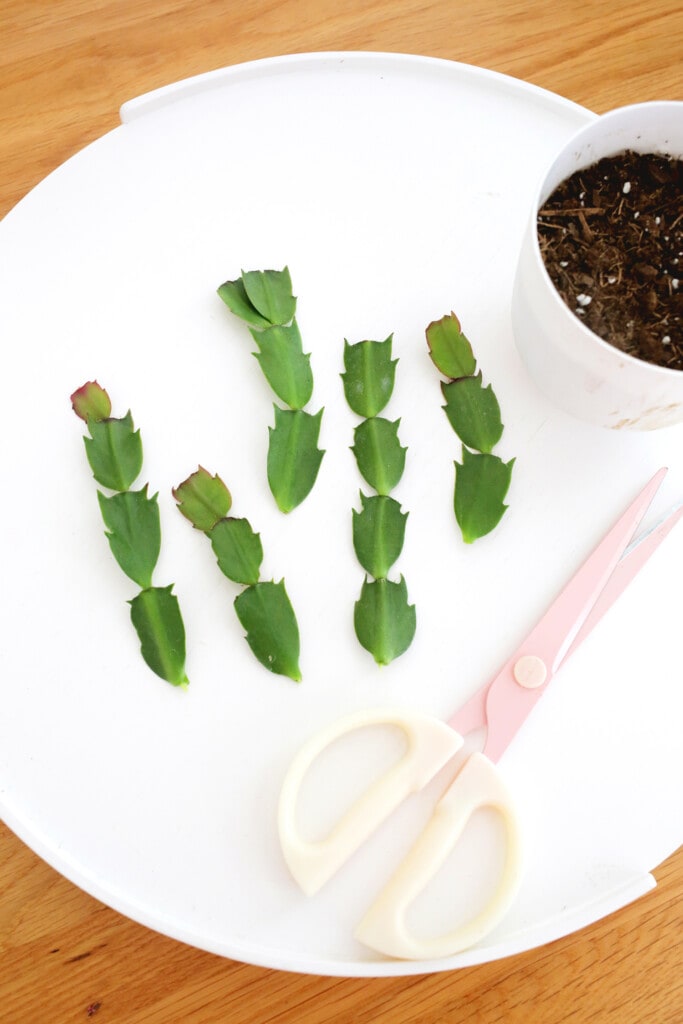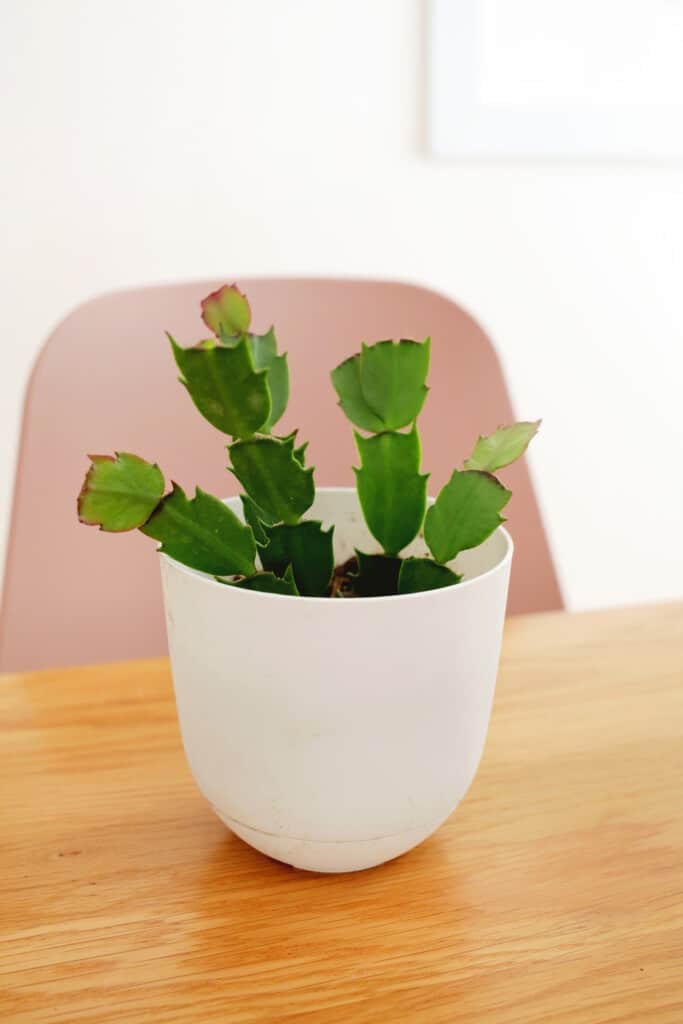The Christmas Cactus (Schlumbergera x buckleyi) is a beautiful plant that gets its spotlight around the holiday season.
The blooms of the Christmas Cactus are triggered by temperature and day length (called a “thermo-photoperiodic” response), so you’ll have to pay close attention to a few details if you want to keep your cactus and have it bloom year after year.
This plant is made of segmented stems with notched details on the edges of the leaves and it blooms tubular flowers in late fall to early winter. Originating from the rainforests of Brazil, it usually grows in crevices of rocks or on trees covered in moss.
Related: Learn to Care for Pilea Plants, Monstera, Jade Plants, Calathea, Spider Plants, Fiddle Leaf Figs, Golden Pothos, Snake Plants, Rubber Trees, and String of Pearls Plants.


Varieties of Christmas Cactus
There are three main types of Christmas Cactus you can choose from:
- Easter Cactus: (S. gaertneri) Bloom from later winter to mid-spring with rounded leafs and tiny bristles at the edges.
- Thanksgiving Cactus: (Schlumbergera truncata) These are often mistaken for Christmas Cacti and bloom from late fall to mid-winter. The flower colors can be red, pink, peach, purple, orange, or white and it features claw-shaped projections on its leaves.
- Christmas Cactus: (S. x buckleyi) Bloom from early to mid-winter with white and magenta flowers. It has rounded flat leaf segments with notches around the edges.
How much sunlight does a Christmas Cactus need?
You’ll want light that is bright but indirect for your Christmas Cactus. While it can tolerate some direct light, you’ll want to minimize it as too much can cause the leaves to burn.
If you are trying to encourage a plant to rebloom next holiday season, you’ll need to give it at least 13 hours of total uninterrupted darkness starting in mid-October in order to get buds to form for the plant to flower.

How often should you water a Christmas Cactus?
While Christmas Cactus do require more water than some other drought-tolerant cacti varieties, watering your cactus too much can lead to root rot, so you’ll want to make sure your cactus dries out enough between watering.
Stick your finger in the soil to check the water level and once the top 2″ of dirt feel dry, give it a good watering. Make sure to use a pot with drainage holes so the plant has good drainage away from its roots.
Should you fertilize a Christmas Cactus?
You can fertilize your Christmas Cactus with a general all-purpose fertilizer monthly when the plant is blooming. If you are trying to keep it past the holiday season, you can keep fertilizing monthly until early fall.
In mid-October, stop feeding and wait until the plant blooms again to resume a monthly fertilization schedule.
Temperature and humidity level for Christmas Cactus
Since they originate from the rainforest, Christmas Cactus enjoy higher humidity and temperatures between 70°F and 80°F. Once buds fully appear, they require lower nighttime temperatures between 55°F and 65°F.
Like most plants, keep it away from heating vents, outside doors, and drafty areas near windows as temperature changes can cause it to drop its buds or flowers.
You can add more humidity to your home with a humidifier or you can put some pebbles and water in a tray and simply place your pot on top (make sure the water level sits below the top of the pebbles). The pot will sit on top of the stones and the water in the tray will evaporate and create humidity around the plant. You can also lightly mist the plant occasionally to add more humidity.
Bathrooms or kitchens are a great spot for Christmas Cactus (as long as it has the proper light for them) as they are a more humid environment.

Pruning Christmas Cactus
While you can snip off faded flowers to redirect the plant’s energy to other areas, Chrismas Cacti don’t need pruning unless your plant has grown larger than you would like and you want to keep it more compact.
Repotting Christmas Cactus
Christmas Cacti are low maintenance in this area as they will actually tend to bloom better when they are a little root bound.
You can replant them into a slightly larger container with good draining soil (in a pot with drainage holes) every three years or so during the spring.


Propagating Christmas Cactus
You can easily propagate Christmas Cacti from cuttings of the original plant. Just make sure to wait until the plant has finished flowering. So, early spring is the best time to make cuttings rather than when it’s forming buds in the fall. All you have to do is:
- Prepare a small pot of potting soil or cactus mix.
- Using sterile scissors or shears, cut off stems of cactus that have 3-5 sections on each stem. You can plant several sections in one pot, so cut up to 5 stems to plant in one container.
- Let the ends dry out for 4-5 days until a callous forms over the cut area.
- Push the dried ends into the soil about 1″ deep using 3-5 stems per pot.
- In about two weeks, your roots will develop but you want to keep it well watered while it’s rooting and you can place a plastic bag over the top to increase the humidity until the roots have taken hold.
- Look for new leaf and stem growth before repotting it in a larger container.

Encouraging Christmas Cactus to bloom
If you want to keep your Christmas Cactus and encourage it to bloom next holiday season, you’ll need to give it some extra TLC throughout the year:
- In mid-October, stop fertilizing and hold off on watering the plant until buds appear.
- Keep your cactus in an area that stays between 50°-60°F.
- Limit the hours of light the cactus receives for the next 6-8 weeks as it needs about 13 hours of uninterrupted total darkness each night (you can place a black cloth over it or put it in a closet). If your room is warmer than 60°, try giving it a few extra hours of darkness each day to make up for the warmer conditions.
- Once flower buds have fully formed, move the plant to an area with bright indirect light and wait for buds to fully open (you don’t need to give them 13 hours of darkness at this point anymore). Make sure to keep watering the plant once it flowers as it may drop its buds if it gets too dry.
- If you find that the cactus buds fall off the first winter, try again as it can still bloom the following year.
Diagnosing common problems
- Blossom drop: Sudden changes in temperature can cause flowers or blossoms to drop, so make sure your plant is situated away from drafty areas or heating vents.
- Puckered or shriveled leaves: Under watering can cause leaves to pucker or shrivel, so feel the soil and if it’s dry, water thoroughly and see if the plant perks up in a day or so.
- Mealy bugs: These tiny bugs can be spotted by the small cottony masses that they build on the plant. Try removing the masses with a toothpick or clean the plant with a soft toothbrush.
- Spider mites: While the actual mites are hard to see with just your eye, if you see tiny spotting or webbing on your plant, you probably have an issue with spider mites. Use an insecticidal soap spray to remove them and keep the plant wiped clean as mites are attracted to dust.
- Root rot: When over watered Christmas Cactus are more susceptible to root rot, so make sure the cactus dries out enough between waterings to avoid conditions that are too soggy.
Frequently Asked Questions
Are Christmas Cactus toxic to pets or kids?
A Christmas Cactus is not poisonous to pets or kids, but it can cause some stomach upset if eaten in large quantities, so it’s best to keep it away from pets or small children that will try and nibble on it.
